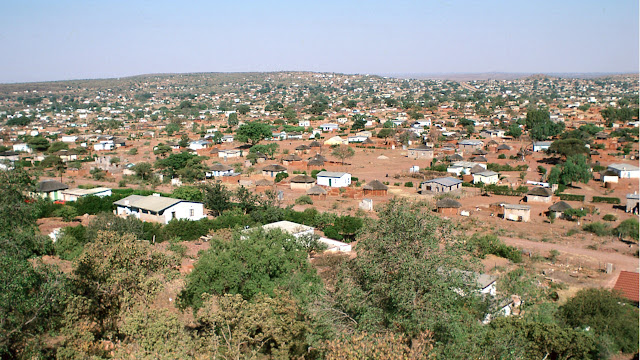Tuesday, 26 May 1987: RIIC Produces Equipment for Rural Botswana
June 12, in route to Bulawayo, Zimbabwe
When my environmental science colleague, Masego Mmputakwane (pronounced ma-SE-ho mm-pu-ta-KWA-ne) invited me to join him on a one-day trip to Kanye, Botswana, of course I said yes. Not only did I welcome the opportunity to visit another part of Botswana, but I’ve found Masego to be “good company” – an upbeat fellow with whom I’d enjoyed stimulating conversations.
View southeast of Kanye, Botswana from Hospital Road. Kanye is a large village with a population of
some 30,000. It is about 100 km (1½ hours)
southwest of Gaborone by car.
The purpose of our trip was to visit the Rural Industries Innovation Centre in Kanye. Masego is hoping to do a research project on the dissemination of technology using RIIC as his main example. The center began operations in 1977 to develop and produce equipment for farming and other primarily rural applications. The products are manufactured using “appropriate technology” (neither high-tech nor energy-intensive) and can be maintained and repaired by users without reliance on skilled technicians from South Africa or imported parts. Furthermore, most of their products do not require electricity or petroleum products to operate. RIIC is funded by the Botswana government and international donor organizations.
Testing an animal-drawn pump assembly at the RIIC Research
and Development Centre.
It appears to me that RIIC is helping Botswana rely less on machinery for rural applications which is imported from South Africa or Western industrialized nations. And it disseminates information about appropriate technology not only throughout Botswana but to neighboring countries. I was impressed by RIIC’s products and their accomplishments in helping Botswana become more self-sufficient.
The RIIC Biogas Plant uses cow dung, reducing diesel fuel use for power generation by 80%.







Comments
Post a Comment